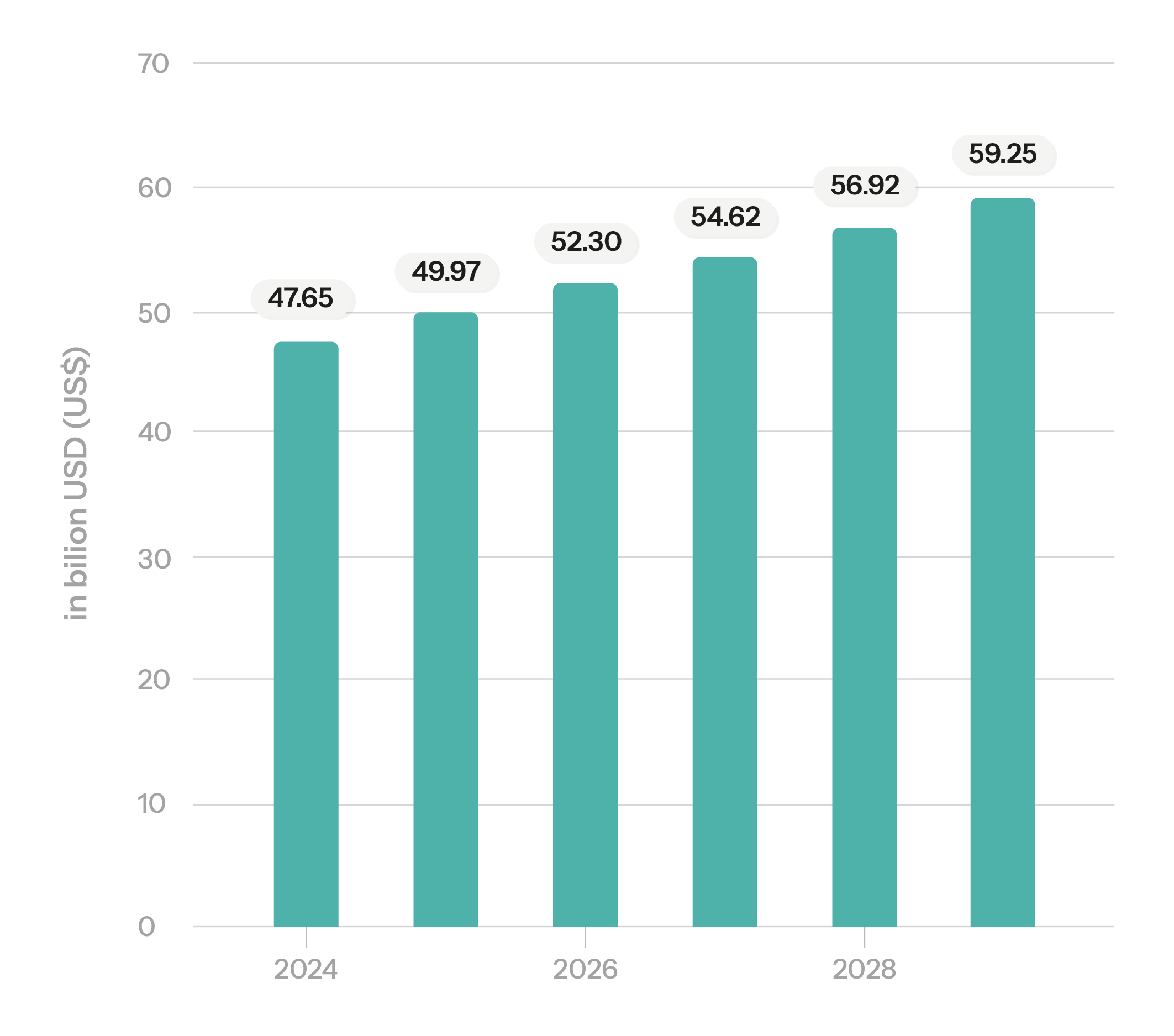Wearable Organic X-ray Sensors: Enhancing Medical Imaging
Wearable organic X-ray sensors represent a commendable leap forward in medical imaging technology. It promises to improve diagnostic capabilities while providing greater patient convenience and comfort. These innovative devices leverage organic materials to create flexible, lightweight sensors that can be worn on the body, allowing for continuous monitoring and imaging.
The blog dives into wearable organic X-ray sensors and market overview, the latest innovations, growth prospects and possibilities, acceptance levels, revenue potential, research developments, demand, key companies and startups, regulatory challenges, and other aspects.
Market Overview
The global Diagnostic Imaging Devices market is expected to generate a revenue of USD 49.97 billion by 2025, with a steady annual growth rate (CAGR of 4.35%) projected between 2025 and 2029. This growth will bring the market volume to US$59.25 billion by 2029. On the global scale, the United States is anticipated to lead in revenue generation, reaching US$12.38 billion in 2025. The U.S. continues to dominate the worldwide Diagnostic Imaging Devices market within the Medical Technology industry, driven by its advanced technology and high adoption rates.
Revenue Over the Years

Source: Statista
Latest Innovations
Recent innovations in wearable organic X-ray sensor technology:
1. Real-Time Radiation Monitoring
These sensors can monitor radiation exposure in real time, enabling healthcare providers to make swift adjustments during radiotherapy sessions. This ensures that treatment protocols are optimized to minimize damage to healthy tissues while maximizing therapeutic effectiveness. The ability to transmit data continuously improves the accuracy and safety of radiation delivery.
2. Printable Technology
The printable nature of organic semiconductors allows for cost-effective manufacturing processes. This innovation not only reduces production costs but also enables scalability in sensor production. These sensors can be printed on flexible substrates, so they can be mass-produced more efficiently than traditional rigid detectors.
3. Integration with IoT and Data Analytics
Many wearable organic X-ray sensors are designed to integrate seamlessly with Internet of Things (IoT) platforms. They allow real-time data transmission to healthcare providers for quick analysis. This integration facilitates better decision-making in clinical settings and enhances patient monitoring capabilities by providing continuous feedback on treatment efficacy.
4. Lightweight and Flexible Design
Lightweight and flexible designs are top innovations in wearable organic X-ray sensors. These organic sensors can be printed on flexible substrates, allowing them to conform to the body’s contours, contrary to traditional silicon-based detectors, which are uncomfortable and rigid for long-term wear. A patient feels comfortable wearing them, and that enables continuous monitoring.
5. Biocompatibility
Organic X-ray sensors are made from carbon-based materials, providing a biocompatible response to ionizing radiation. This characteristic is important for wearable applications, as it reduces the risk of adverse reactions when the sensor is in contact with the skin for a long time. The biocompatibility of these materials offers new avenues for personalized medicine, particularly in sensitive applications, including cancer treatment, where lessening the side effects is paramount.
6. High Sensitivity and Precision
Recent studies have surfaced that wearable organic X-ray sensors can accurately detect incident X-rays. It shows a tolerance comparable to traditional silicon detectors. For illustration, under conventional radiotherapy conditions, these sensors can transmit 99.8 percent of the radiation beam while precisely detecting X-rays with an accuracy of 2 percent. This high sensitivity makes them suitable for different applications, like advanced treatment modalities like Microbeam Radiation Therapy.
Enhanced Safety Protocols
The ability to monitor radiation exposure directly on the patient enables improved safety protocols during treatments. Healthcare providers can adjust treatment plans dynamically by offering real-time data on radiation levels received by patients, reducing the risk of acute side effects commonly associated with radiotherapy.
Growth Prospects
The growth prospects for wearable organic X-ray sensors are robust due to several factors:
- Increasing Demand for Remote Monitoring: The COVID-19 pandemic has pushed the adoption of remote healthcare solutions. Wearable sensors facilitate uninterrupted monitoring without requiring patients to visit clinics, hospitals, or healthcare facilities.
- Aging Population: As the population worldwide ages, there is a growing requirement for advanced medical imaging solutions that can offer timely diagnostics while reducing patients’ discomfort.
- Technological Advancements: Current research into organic materials and sensor technologies continues to fuel innovation, allowing for effective and user-friendly devices.
Acceptance and Demand
Acceptance of wearable organic X-ray sensors is gradually increasing among both healthcare professionals and patients. Factors contributing to this acceptance include:
- Patient Comfort: The lightweight and flexible design makes these sensors more comfortable compared to traditional rigid imaging devices.
- Enhanced Diagnostic Capabilities: Healthcare providers recognize the potential for these sensors to improve diagnostic accuracy through continuous monitoring and real-time data collection.
Research and Revenue Potential
Research into wearable organic X-ray sensors is expanding rapidly. Key areas of focus include:
- Material Development: Researchers and scientists are exploring new organic compounds that improve sensitivity and minimize production costs.
- Clinical Trials: Ongoing clinical trials are assessing the efficacy and safety of these sensors in various medical applications.
Key Companies and Startups
Several companies and startups are pioneering developments in wearable organic X-ray sensor technology:
- Nanomaterials Technology Inc.: Specializes in developing advanced organic materials for sensor applications, focusing on enhancing sensitivity and flexibility.
- Sensible Medical Innovations: This startup focuses on creating wearable medical devices that utilize advanced imaging technologies, including organic X-ray sensors.
- Xsensory Technologies: A company dedicated to developing next-generation imaging solutions that integrate wearable sensor technology with AI-driven analytics.
- Philips Healthcare: An established player in medical imaging that is investing in research related to wearable technologies, including organic X-ray sensors.
- Siemens Healthineers: Actively exploring innovations in imaging technologies that could include wearable solutions for patient monitoring.
Regulations and Challenges
As with any emerging technology in healthcare, wearable organic X-ray sensors face regulatory challenges:
- Regulatory Approval: Getting approval from regulatory bodies like the FDA can be arduous, requiring extensive clinical data exhibiting efficacy and safety
- Standardization: The dearth of standardized testing protocols for wearable devices can complicate regulatory approval processes and market entry.
- Data Privacy Concerns: As these devices collect sensitive health information, ensuring data security and compliance with regulations such as HIPAA is crucial.
Advantages
Wearable organic X-ray sensors offer numerous benefits:
- Continuous Monitoring: These devices allow ongoing assessment of patients’ conditions without frequent hospital visits.
- Reduced Radiation Exposure: Enhanced sensitivity enables high-quality imaging at reduced radiation doses compared to traditional methods.
- Enhanced Patient Experience: The comfort of wearing lightweight sensors can lead to better patient compliance with monitoring protocols.
- Real-Time Data Analysis: Integration with IoT platforms enables quick data transmission to healthcare providers, allowing timely interventions when necessary
Conclusion
Wearable organic X-ray sensors represent a transformative advancement in medical imaging technology. With the potential for uninterrupted monitoring, enhanced comfort, and improved diagnostic capabilities, these devices are set to play an important role in the future of healthcare.
As research advances and acceptance grows among providers and patients, the market for wearable organic X-ray sensors is slated for significant expansion, paving the way for innovative solutions that enhance patient care while addressing the challenges faced by traditional imaging methods.



